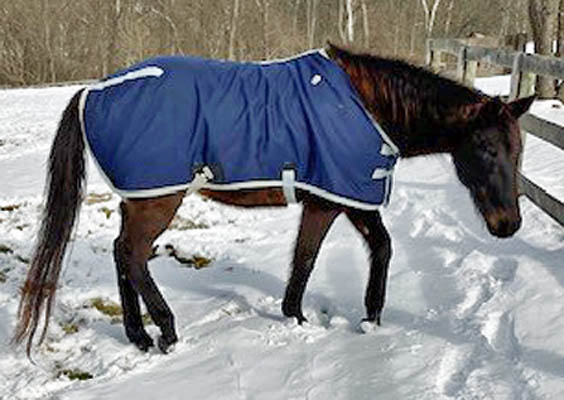Blanketing Horses


I am sure there is all kinds of advice out there about whether or even if to blanket horses in cold weather. I can tell you what I do and, in the final analysis it is a matter of preference.
Certain Siberian breads of horses are well-adapted to arctic conditions, having a natural double layered coat. My wife’s one Thoroughbred was not at all adapted and I recall walking down to the barn on cold a morning and seeing the poor horse shivering. It broke my heart to see her like that and I hotfooted back to the house and broke out her blanket. Clearly, there is a lot of individual variation in horses’ tolerance of cold. It is no surprise that a Thoroughbred, having Arab blood, might have a thinner coat and be less well-adapted to cold than many other breeds.
The rule of thumb that we follow is to have our horses without blankets until the nighttime temperature is forecast to drop below 10 degrees. If there is a wind-chill we will take that into account, but our horses are free to be either outside or inside and if the wind is bad enough, I am confident they will come in. It is not surprising that companies selling blankets suggest a temperature of 32 degrees and veterinarians look at when temperature impacts a horse’s physiology. I am rather alone saying 10 degrees. I can only point out we do not blanket wild animals. Nature takes care of its own. Here is Maryland we generally do not have very low temperatures and I figure their normal cold responses might be challenged. Older or ill horses require a more liberal blanketing routine. Blanketing does not impede normal winter coat grow. Particularly hunters are often clipped so that intense exercise does not over heat them in the winter. These horses, of course, require a blanket. Blankets should be waterproof.
I also give them hay either under cover or outside. In cold weather I am very liberal, giving them more hay since the fermentation of hay is an internal heat source for a horse. They seem to prefer eating outside for some reason. I suppose it is a prey animal’s fear of being boxed in.
There are several types of blankets and different placement of straps on them. I have no preference other than to say that you do not want to be putting an unfamiliar blanket on the first time during a windy, dark, cold night and discover that you do not know how the fasten the straps down. It is a good idea to check in out in advance. A typical blanket has two buckles in the front and two straps that crossover the horse’s body and close by a catch that is just twists into place. The straps are adjustable and need to fit your horse properly. If they are too loose the blanket can shift or the horse can catch a leg in the straps. A blanket that is too tight is uncomfortable for the horse. There is a second kind of strap arrangement that is better for mares. This features three straps. One goes directly under the forward underpart (barrel) of the horse and the other two , called back straps, come off the bottom rear of the blanket and crisscross under the legs, fastening farther up on the side of the blanket edge. Since a mare urinates and defecates in a backwards fashion the straps remain clean. Put on correctly this design is very stable in place.
When I put on a blanket, it is first folded in half inside out and then in thirds in such a way that the top fold is the first third of the blanket. Place it on the horses back and flip the far side over the horse so that the blanket is now no longer inside out. Then pull the rest of the blanket towards the horse’s rear. Across over to the other side and straighten the blanket so that it fits well on the horse. Blankets have a nice central stripe to aid in positioning. Then you fasten the front buckles and next the close the strap fasteners. I have also known persons who blanket with the front (chest) buckled done and just draw the blanket over the horse’s head and body. It is short and sweet and if the horse is used to this no problem. However, I worry that a horse might panic while being blanketed and I suspect those doing this kind of thing spend some time training the horse to accept blanketing done in this fashion.